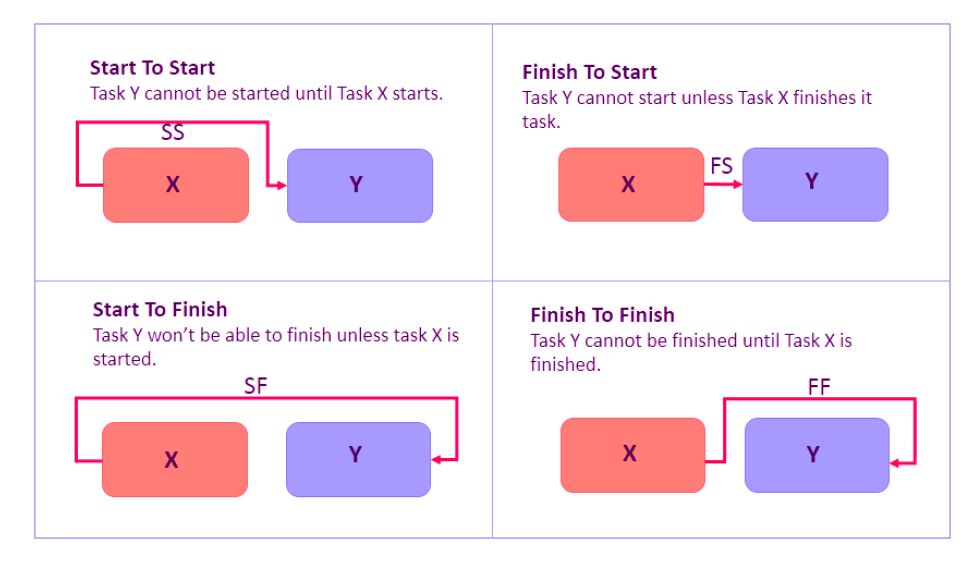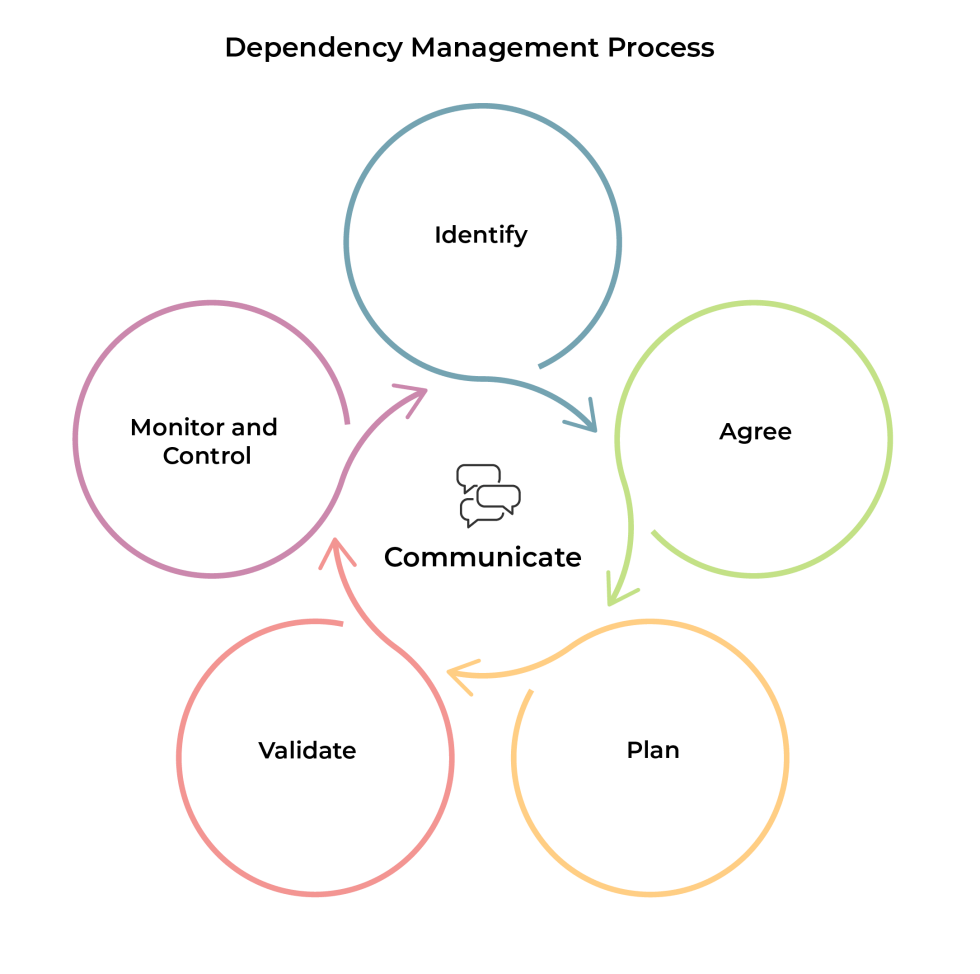Project Management Guide
Project Management Guide
What Is Project Management?
What Is a Project?
Why Is Project Management Important?
Project Life Cycle Phases
- Project Initiation
- Project Planning
- Project Execution
- Project Monitoring
- Project Closure
Project Management Methodologies
- Waterfall Project Management
- Critical Path Method
- Critical Chain Project Management
- Agile Project Management
- Scrum Project Management
- Kanban Project Management
- Lean Project Management
- Six Sigma Project Management
- PRINCE2
- PRiSM
- PMBOK Method
Project Management FAQ
What Is a Dependency in Project Management?
What are Project Management Dependencies, and How do You Manage Them?
You wake up, check your mail, have a bath and breakfast, and drive to the office.
For many, that’s a typical start to the day. Yet, all those actions are dependent on each other. In this example, the right order of activity, as well as electricity, water, and roads, are some of the dependencies.
It’s the same with project management. One glossary of project management terms defines dependency as “a relation between activities, such that one requires input from the other.” With a dependency, “the next task or group of tasks cannot begin until preceding work has been completed.”
In this guide, we’re going to cover:
- The importance of dependency management
- Types of dependencies
- How to manage dependencies
These are essential elements to understand and master. Viewing a project as a large series of interlinked parts goes a long way in proper planning and execution.
The Importance of Dependency Management
As a project manager, you must already know of the constraints that every project faces. This is the famous triangle of cost, scope, and time. Successful completion and quality depend on effectively managing these three

Such constraints often lead to dependencies. For example, if part of the project scope is to cut down ten trees, and costs permit only one axe, then the cutting down of one tree is dependent on successful cutting down of the previous one.
Managing dependencies is critical when it comes to handling and finishing all the related processes of a project. This helps to:
- Prioritize tasks, resources, and activities so that the most important ones are handled first, leading to optimum allocation of resources.
- Create operational deadlines so that the path to project completion is without blocks or barriers.
- Work out an efficient workflow that provides the right resources at the right time.
- Keep the project moving smoothly without any delays in starting new tasks that are dependent on earlier ones.
Not only does dependency management keep a project well-oiled and on course, but it can also prevent risks from arising and upsetting deadlines.
As a conference paper at the Project Management Institute puts it, without a proper work breakdown, “the work to be accomplished will flounder, and the schedule will be unorganized and for the most part not executable.”
Once project dependencies have been thought through and mapped, the timelines become robust, and work proceeds efficiently.
Types of Dependencies
Dependencies vary according to the nature, size, and complexity of the project. It can be helpful to look at dependencies in three ways:
- Logical dependencies: these are dependencies that are natural and inherent. Some steps simply cannot be completed unless previous steps have been completed first. For example, you cannot drive to your destination without first having enough petrol in the tank.
- Resource dependencies: these are dependencies that are led by constraints. In an ideal scenario, project managers would have unlimited resources and personnel to tackle jobs as simultaneously as possible. Because this is never the case, the tasks and order can become dependent on the resources available to execute them.
- Preferential dependencies: these are dependencies that come about because of quality parameters. They are linked to the standards of deliverables expected. When laying a road, for example, the construction team will have a number of days to water the concrete to make sure it is strong.
Logical, resource, and preferential categories apart, there are specifically four types of dependencies that should be understood, identified, and managed.
- Finish to start: In this case, Task 2 cannot start until Task 1 is completed. An everyday example would be that you cannot travel in a lift from one floor to another unless you press the button for that floor.
- Finish to finish: Here, Task 1 can only finish when Task 2 ends. This is often seen in software development. The quality and review team can test for bug fixes, and then hand the report back to the developers, who complete their task.
- Start to start: In this case, Task 2 cannot start before Task 1 starts. Both are intrinsically linked. When glue is placed on a surface, for example, the material that needs to be stuck must be instantly placed on it before the glue dries up.
- Start to finish: In this scenario, Task 2 must start for Task 1 to be completed. For example, a person on a certain shift cannot leave until the person in charge of the next shift arrives.

The above are dependencies that are related specifically to the internal nature of a project. But there can be another type of dependency that project managers should take into consideration.
These are external dependencies. Often, there are factors beyond the control of the project team but they should be reflected in the project schedule nevertheless.
These could be approvals from external authorities for permission to start work. Or they could be the availability of a certain type of resource that may have become scarce.
In this way, the wise project manager will plan for and map all external and internal dependencies before starting a project, to ensure greater chances of success.
How to Manage Dependencies
When used correctly, most project management tools will display the dependencies that the project manager will need to be aware of. Inputting the right constraints and tasks will display the links between them.
It’s important to communicate with all stakeholders and to first make a list of dependencies. Following this, responsibilities and resources can be assigned, with manageable deadlines.
The project constraints also need to be logged. Specifically, attention should be paid to which ones can be managed and which ones are fixed. The connection between constraints needs to be understood.

As mentioned, risks also need to be carefully considered. The project manager can then determine alternative approaches and whether dependencies among them need to be taken care of.
Finally, a reporting system can be created. This is important so that dependencies between tasks are effectively handled with no loss of time between the completion of one and the start of another. Priorities can be identified and monitored.
When project dependencies are correctly understood and managed, the entire team works together as one force towards a common destination. This way, projects can be completed with optimum use of resources, and on time, to everyone’s satisfaction.
